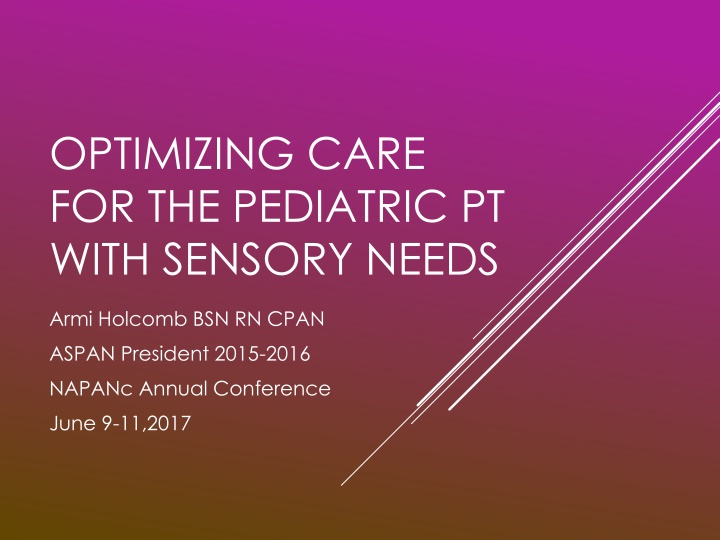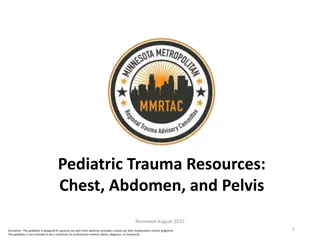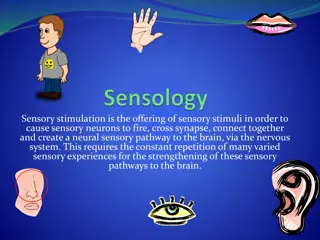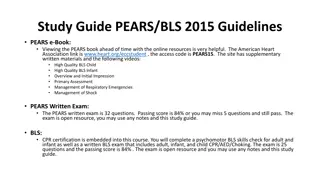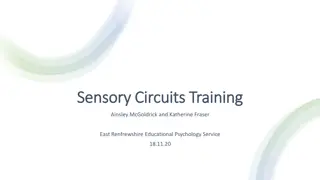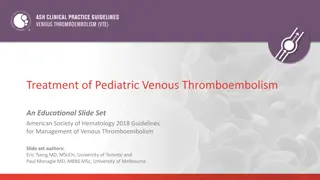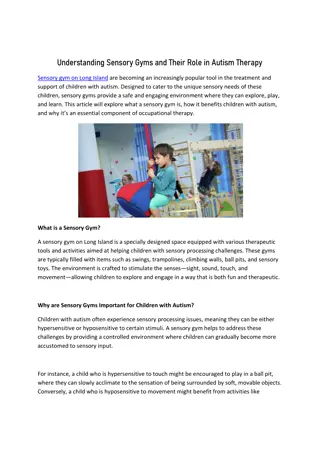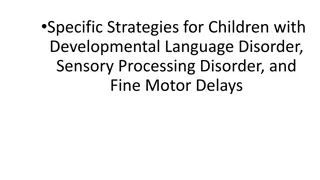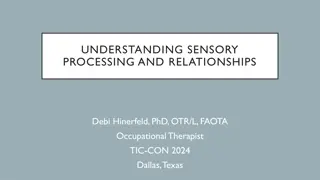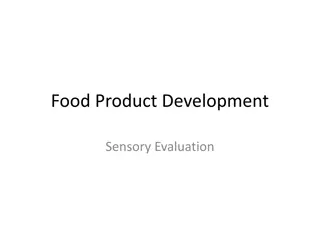Optimizing Care for Pediatric Patients with Sensory Needs
Sensory processing difficulties in pediatric patients can impact daily activities. Learn about Sensory Processing Disorder (SPD), its subtypes, signs, and management strategies. Discover how to identify patients with sensory challenges and de-escalate situations effectively.
Uploaded on Mar 05, 2025 | 1 Views
Download Presentation

Please find below an Image/Link to download the presentation.
The content on the website is provided AS IS for your information and personal use only. It may not be sold, licensed, or shared on other websites without obtaining consent from the author.If you encounter any issues during the download, it is possible that the publisher has removed the file from their server.
You are allowed to download the files provided on this website for personal or commercial use, subject to the condition that they are used lawfully. All files are the property of their respective owners.
The content on the website is provided AS IS for your information and personal use only. It may not be sold, licensed, or shared on other websites without obtaining consent from the author.
E N D
Presentation Transcript
OPTIMIZING CARE FOR THE PEDIATRIC PT WITH SENSORY NEEDS Armi Holcomb BSN RN CPAN ASPAN President 2015-2016 NAPANc Annual Conference June 9-11,2017
Identify patients who have or potentially have sensory processing difficulties. Discuss strategies for managing patients with sensory processing disorders while providing care. Describe how to de-escalate situations involving patients with sensory processing disorders OBJECTIVES
What is Sensory Processing Disorder or SPD Sensory processing is also called sensory integration. It is the way our nervous system receives messages from our senses and turns them to appropriate motor and behavioral responses.
Continuation: PEOPLE OR CHILDREN THAT HAVE SPD OR SID ( SENSORY INTEGRATION DSYFUNCTION) FIND IT DIFFICULT TO PROCESS THE MESSAGES AND ACT ON THE INFORMATION RECEIVED FROM THE SENSES- IT IS LIKENED TO HAVING A TRAFFIC JAM . WE TAKE FOR GRANTED TAKING A BITE FROM YOUR SANDWICH, RIDING A BIKE, OR EVEN READING A BOOK. THESE ACTIONS NEED SUCCESSFUL PROCESSING FOR THEM TO HAPPEN
SENSORY MODULATION DISORDER IS ONE OF THE CATEGORIES OF SPD Three subtypes: 1. Sensory over responsivity 2. Sensory under responsivity 3. Sensory craving/seeking
SIGNS AND SYMPTOMS OF OVER- RESPONSIVITY Dislike textures such as found in fabrics or foods Avoid crowds and noisy places Motion sickness not related to other medical explanation Refuse normal skin contact such as kissing, hugging or cuddling Feel seriously discomforted by normal sounds, light, movement, smells Picky eaters Sleep disorder- waking to minor sounds or problem falling asleep because of sensory overload Difficulty to self calm
S&S FROM UNDER RESPONSIVITY Show difficulty waking up Appear unreactive or slow Be unaware of pain or other people Might appear deaf even when auditory functions have been tested Child might be difficult to toilet train- they are unaware of being wet or soiled
S&S OF SENSORY CRAVING Fidgets excessively Seek or make loud disturbing noises Climb, jump or crash constantly Suck on or bite clothing, fingers or pencils Appear impulsive
WHAT IS AUTISM? It is a bio- neurological development disability that generally appears before the age of 3 Autism impacts the normal development of the brain in the areas of social interaction, communication and cognitive functions Individuals with autism suffer from numerous co- morbid medical conditions which may include allergies, sleeping disorder, asthma, digestive disorder, feeding disorders, sensory integration dysfunction
AUTISM FACT AND STATS Affects 1 in 68 children Boys are 4 times more likely to have autism than girls 40%of children with autism do not speak, 25-30% have words at 12-18 months then lose them. Others may speak but not until late childhood. No two people with autism are alike
Austism is diagnosed four times more often in boys than girls. Its prevalence is not affected by race, religion or socio economic status MORE FACTS
RACE CAR DRIVER JAMIE MCMURRAY TALKS ABOUT AUTISM
Currently there is no cure for Autism but with early intervention and treatment of the diverse symptoms related to autism, greatly improves and in some cases completely overcome.
Autism itself does not affect life expectancy, however research has shown that mortality risk among individuals with autism is twice as high than the general population in large part due to drowning or other accidents
Rate of autism has steadily increased in the past 20 years Is it because it was not diagnosed properly? Are we just more aware of the spectrum disorder?
THIS IS A GRAPH UP TO 2009, IN 2014 THE PREVALENCE IS 1 IN 68
STRATEGIES TO HELP OPTIMIZE HOW TO CARE FOR PTS WITH SPD/AUTISM
At CMH we ask parents to complete a questionnaire to better able to deal with their child with SPD with or without dx of Autism, Aspergers, Downs syndrome, brain injury and communication delays STRATEGIES
IN THE HEALTHCARE SETTING CHILDREN WHO ARE EXTRA SENSITIVE TO SENSORY INFORMATION MAY HAVE DIFFICULTY WITH SOME OF THEIR MEDICAL CARE Becoming upset in busy waiting rooms or as in a mall Crying when having blood pressure taken Hiding from the staff and refusing to interact Becoming unreasonably upset when asked to start a new activity Covering their ears when new people are talking Hiding their eyes when new people talk or with bright lights
CALMING SENSORY STRATEGIES Proprioceptive input: any input which pushes or pulls on the body s joints or deep pressure to the body muscles Tactile Input: How things touch your body Visual Input: what your child sees Auditory input: what your child hears Oral input: what your child eats or puts in his mouth Vestibular input: how you child moves relative to the ground
EXAMPLES OF PROPRIOCEPTIVE INPUT: Bear hugs/comfort holds Playing/positioning on his tummy so he has to push up with his arms use Ipads or book while waiting, it also diminishes visual input in a busy room Swaddling/wrapping in a blanket Weighted lap pads either on their lap or if in supine or prone position place over torso Use vibration toys spinner toys that vibrate, mini massagers Arm hugs/squeezes
EXAMPLES OF TACTILE INPUT Firm touch is more calming than light touch or tickles Stroking child s back rhythmically from top to bottom Gently squeeze your child s hand or feet while you count Warm blankets or towels- of course not recommended if pt is febrile
EXAMPLES OF VISUAL INPUT Watching patterns is often calming to children iPad games such as Thicket or Neon mania Spinner toys Limiting visual input such as turning down the lightsor closing the blinds Decrease eye contact or approaching child from the side
EXAMPLES OF AUDITORY INPUT Slow rhythmic music is calming Listening to lower tones rather than higher tones Limiting unexpected loud sounds Talking in slow low tones Have a familiar person be the primary speaker rather than many voices Use headphones to reduce auditory input Closing the door to the room Room assignment or in the PACU put is a more isolated area
EXAMPLES OF ORAL AND VESTIBULAR INPUT Chewy toys, they can chew their shirts, hands or even an IV tubing Chewing gum is calming Sucking objects like pacifiers or a straw For vestibular: moving in one direction such as swinging back and forth or jumping up and down or rocking
STORY TELLING Charlie s Story JJ s Story Ripped from the headlines
Body poll: How many have taken care of pts with some sensory processing issues? 1. How many know of someone with a child who has some SPD? 2. How many have a relative child, brother, sister, cousin who has SPD? 3. IN CONCLUSION
QUESTIONS? THANK YOU!!!
